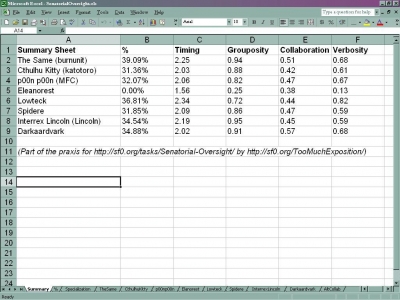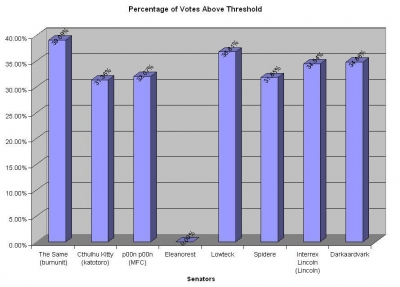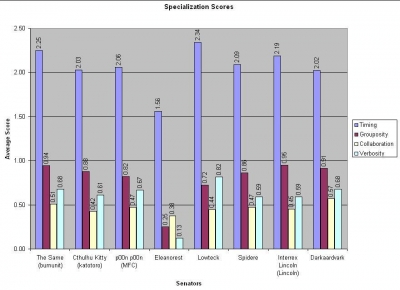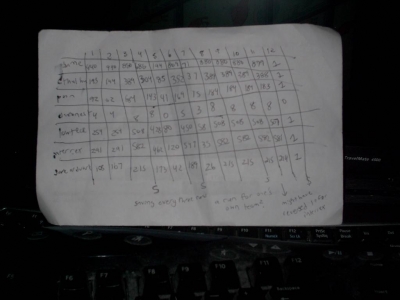

Senatorial Oversight by Too Much Exposition
January 27th, 2008 1:31 PM / Location: 40.723957,-73.97585Data analysis is one of my favorite faux-procrastinatory outputs at my real job because each book has so much juicy information to play with (ISBNs! Pub dates!). Since I made myself stay home all weekend, purportedly to force me to edit a book, of course this task screamed out to me.
I was a little nervous embarking on this task because I’m too new to SF0 to be at all sure what its most important values are (if any). What I can do is itemize a few universal ideals for which the senators’’ voting record provides some evidence of their beliefs, then apply an unimpeachable numerical assessment to their adherence to that ideal. I’ve decided to call this method of analysis QUASAR--that is, Quantitative Uniform Analysis of Senatorial Approval Record--because who doesn’t like dorky acronyms?
Scoring
After pondering for awhile, I decided to focus my analysis on Timing, Grouposity, Collaboration, and Verbosity. Each vote would be assessed on these measures and assigned a certain number of points for their adherence to them, then all four point values would be summed to form the total score for that vote. Here’s how I defined them:
1. Timing
Timing was scored on a 3.5 point scale based on the days of the week. Here’s how each day scored:
Monday: 3.5
Tuesday: 3
Thursday: 2.5
Wednesday: 2
Friday: 1.5
Sunday: 1
Saturday: .5
Obviously, the weekdays above are not listed in any canonical order. The hidden logic is that I’ve awarded points in reverse order of my own ranking of the “best” days of the week. The rationale is that votes cast on a less awesome day are worthier since (a) they demonstrate that the senator remains devoted to the game even while undergoing the rigors of a normal work week, and (b) votes cast early in the week are more effectual since they brightening the day of someone who has a full work week ahead of them rather than someone who’s just settling into a lovely weekend.
2. Grouposity
Grouposity (not to be confused with Grouposis) is a measure of how much the senator has been encouraging group loyalty and collaborations between the groups. It may seem counterintuitive to consider both of these at once, but I believe the following scale enumerates it effectively.
4 points for a vote for any task that includes all groups (for values of “all” that equal “five or more”, since most votes were cast during previous eras anyway)
3 points for including multiple groups
1 point for a specialization (tasks that can only be done by a particular group)
0 points for a general task
3. Collaboration
Next, the vote can score up to four points for awarding collaboration--that is, the more people participated in a task completion, the more a vote for it is worth. In other words
3 points for tasks done by a group of four or more
2 points for a trio
1 point for a pair
0 points for solitary completions
4. Verbosity
And, finally, my personal favorite: verbosity (as if my fondness for it wasn’t evident from this completion). This awards votes for tasks with the greatest number of words in their title. The breakdown I chose was:
4 points for tasks with seven or more words in the title
3 points for tasks with six words in the title
2 points for tasks with five words in the title
1 point for tasks with four words in the title
0 points for tasks with one, two, or three words in the title
(I do realize that a number of these “virtues” don’t stand up to heavy analysis, but given the sheer number of votes under consideration, I’m hopeful that the averages will tell us something.)
This adds up to (3.5+4+3+4=) 14.5 possible points, and I decide that a vote must score 5 or more points to count in the senator’s favor. Admittedly, 5 is sort of arbitrary--I picked it because it’s about one-third of the maximum possible score, and because it intuitively makes sense to encourage Senators to average slightly more than one point for each of the four criterion--but the ranking of the percentages stays about the same no matter what I put there (within reason), so I wasn’t too worried about it.
After that was settled, I went to work figuring out how to extract the data that would tell me what I needed to know. My description of how I did so is too long and detailed to go into here, but I do go into detail in Methodology.rtf, which explains how I obtained and prepared the data in SenatorialOversight.xls.* I’d definitely suggest taking a look at those two files if you want to see the nitty-gritty, but I suspect that most people will be more interested in the results. So, without further ado...
teh winnar
After all was said and done, the senators ranked as follows:
The Same (burnunit) 39.09%
Lowteck 36.81%
Darkaardvark 34.88%
Interrex Lincoln (Lincoln) 34.54%
p00n p00n (MFC) 32.07%
Spidere 31.85%
Cthulhu Kitty (katotoro) 31.36%
Eleanorest 0.00%
Congratulations, Senator Burnunit! It pleases me to note that two of my top three scorers have platforms that I voted for anyway (I realize that those votes were logged within the last 24 hours and may look contrived, but that’s just because I hadn’t read any of the senatorial platforms save Spidere’s until embarking on this task). It pleases me less that I couldn’t give Eleanorest more of a showing here, but that’s a fluke of the statistics that’s unavoidable when the next-lowest vote count is more than 20 times greater than yours.
I’d also like to give props to the specialization leaders: Senator Lowteck, who scored highest on Timing and Verbosity; Senator Lincoln, who took the lead in Grouposity; and Senator Darkaardvark, who scored highest on Collaboration.
Here’s how everyone stacked up… graphically!

 Beyond the Results
Beyond the ResultsWhile the results I got for myself were interesting, I’m more excited by the idea that the attached Senatorial Oversight and Methodology documents might be able to provide a service to the community by acting as a universal tool for people to explore their own beliefs and develop their own analysis. Now that the vote data has been organized, an interested constituent could easily change the reward scales assigned to specific concerns so that they better reflect their own priorities within the game.
Furthermore, it’s possible to program entirely new formulas that investigate other values. A few measures that I considered but didn’t ultimately run with were:
- reward loyalty: bonuses for tasks from the senator’s own group
- penalize the senator for votes for tasks from a group you don’t like
- reward the senator for votes for your group
- ...or for votes for your friends
- assess frequency of voting
- increase the value of votes for tasks that other senators didn’t vote for
If any player or senator has a particular angle they’d like to explore, I’d be happy to help them do so, time permitting.
Just to give an example, while I was reading past completions while working on this task, I saw several references to Burnunit’s theory that the real currency of sf0 is collaboration. Consequently, I found it interesting that he’s actually a ways behind Darkaardvark on my collaboration scale. I began to wonder if that was because I was maxing out the Collaboration reward at 3 points, so I became curious how that would change if I extended the rewards for voting for collaborative tasks virtually ad infinitum by n-1 points for an n-person collaborative task (that is, a seven-person task would get six points). I decided to try this out on the AltCollab tab of the Excel spreadsheet. Curiously, using this method actually increased Darkaardvark’s lead and moved Lincoln to second place. I certainly have no desire to undermine Senator Burnunit’s excellent idea, but I thought it was cool to see how it bore out numerically.
[I also found it interesting that the top three scores in this scenario--1.29 for Darkaardvark, .87 for Interrex, and .82 for Burnunit--exceeded or approached 1, especially given that the senators were still voting for single-completions about 70% of the time, but I don’t have the statistical chops to appreciate this on more than a facile level. I wouldn’t mind comparing these numbers to voting trends for the game as a whole, but that seemed like a big enough effort that it’s probably beyond the scope of even this o’erearnest completion (especially since it didn’t occur to me until I stumbled upon Spidere’s efforts that I might be able to go straight to the database. Yeah, I feel a little dumb about that.)]
Thanks so much for reading! I look forward to your thoughts.
results.jpg

The summary sheet from the analysis spreadsheet, which shows basic results for all eight senators. As you can see, there are 11 other worksheets in the document, so you may wish to download it for the full story.
percentage.jpg

Primary results: a graph comparing the percentage of each senator’s votes that scored above a particular point threshold.
specialization.jpg

Secondary results: a graph comparing the senators’ average score on each of the four composite measures.
handwritten.jpg

Just so this isn’t an exclusively digital completion, I’m throwing in a picture of the page where I recorded the results of my find-and-replace runs. This handwriting sample may also explain why I do most of my work digitally.
SenatorialOversight.xls
The Excel file comprising all of the data and the calculations I used to tame it.
21 vote(s)

Tøm
5
Jackie H
5
Haberley Mead
5
JJason Recognition
5
susy derkins
5
Lank
5
Burn Unit
5
Bex.
5
GYØ Ben
5
Augustus deCorbeau
5
Darkaardvark
5
Ben Yamiin
5
Spidere
5
Flitworth
5
Optical Dave
5
Chance Hale
5
NHØ Bananapants
5
James Grant
5
Julian Muffinbot
5
Sparrows Fall
5
Dela Dejavoo
Favorite of:
Terms
(none yet)5 comment(s)
I was going to vote, but seeing as how I was nearly dead-last in the 'Timing ' category, you're going to have to wait till Monday to get a vote.
No no, your numbers don't deceive you viz. your collaborations scale. It could be that I'm poor in this regard, as in impoverished. Or, Like all great theoretical economists I don't actually do what I think is true.Really, It's been a function of the nature of my personal life that's led to a lot of solo tasking on some—or long distance collaboration on others. Darkaardvark your comment is perfect, by the way.
Also, how 'bout factoring in that, considering our respective vote totals, BU has probably voted for more collaborations than say, myself, while his overall percentage is smaller: perhaps because, as a function of the total tasks completed, only a fraction of tasks are collaborations? Perhaps BU has voted for every single collaborative task and so his overall percentage is lowered once he votes for more non-collaboration tasks.
Susy: Thanks! I actually wondered if that measure was too silly and nearly took it out at the last minute, then I thought: who am I kidding? I'm pretty silly.
DA1: Oooh, point taken (and, indeed, a perfect comment). Thanks for eventually getting around to it.
BU: In addition to your ecconomist comparison (which is certainly valid), I'd also hasten to add that, it is neither expected nor necessarily in a population's best interest for an elected official to behave exactly how he would urge his citizens to do. Though in this case the score cited in this report simply applies to the tasks you voted for, not the ones you yourself participated in--but as DA points out below, you may also just be impoverished w/r/t great collaborations for you to vote on.
DA2: A very interesting and credible theory. It would take me a whole lot of brute force calculation to figure out exactly how many of the ~6540 praxis to date have been collaborative, but if the trends from the first 5 pages of praxes hold true, it's probably only 6-10% of them. So if we presume that there have been about 400 collaborative completions and BU voted for 257 of them, that is indeed a pretty impressive percentage.
The rest of you: thank you for honoring my extremely nerdy completion with your votes. I promise that the next and subsequent ones will be more active.













Vote for the hidden logic behind the Timing parameter: measuring devotion, generosity, ablity to cope with stress, all wrapped up in a number.